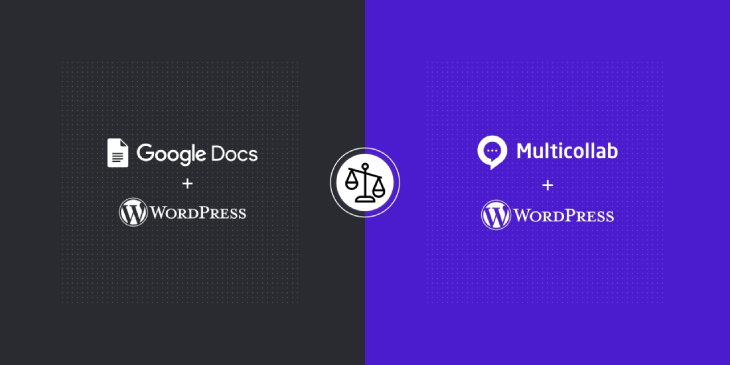Table of Contents
Many content creators and publishers use Google Docs or similar documenting tools to create, edit and collaborate on content before publishing. Tools like Google Docs and Microsoft Word have become a default part of the publishing workflow. The problem with this workflow is that it forces publishers to take their content out of WordPress, which is very inefficient, slow, and frustrating.
We encourage a new approach and invite you to try a new workflow, where you create, edit, collaborate, and publish blogs and news in your favorite blog editor — WordPress.
This side-by-side comparison will help you understand why Google Docs is not the right tool for your WordPress publishing workflow.
Google Docs vs Multicollab
This side-by-side comparison will help you understand
why Google Docs is not the right tool for your Publishing Workflow.


Fundamentally designed for document creation.
Fundamentally designed for blog and news publishing.
No option to customize and design your own publishing workflow.
You are in total control of creating your own publishing workflow in WordPress.
It has very basic options and controls for content formatting.
It has uber-rich and more-advanced content formatting elements and options.
Each collaborator must have a Google account to collaborate on content.
The collaborator should be a WordPress user but can use any email services.
You may need to invest more time in reformatting once you copy your content to WordPress.
You save time by drafting and editing your content directly on WordPress, so there is no need to do reformat.
Constantly toggling between Google Docs and WordPress for content collaboration slows your team down, jeopardizing your ability to meet deadlines.
You draft, edit, collaborate, and publish content without leaving WordPress editor, enabling you to publish faster.
Your content and data go outside your own server infrastructure.
Your blog content stays on your server only, alleviating any concerns about the privacy and protection of your data.
You can’t create your own custom permissions and roles for collaborators.
You can create your own custom roles and permissions for authors, editors, and collaborators.
Offers collaborative features such as inline commenting and suggestions.
You can add further collaborative options such as comments and suggestions with WordPress plugins like Multicollab.
Your investment of time and money to build customized and reusable content blocks are wasted because you can’t use them in Google Doc.
You can achieve a swifter and higher-quality content creation experience by employing reusable, customizable blocks designed for your business and workflow.
There is no option to receive collaboration notifications on Slack or other third-party tools
You can opt to receive comment notifications on Slack or other platforms using Multicollab.
Co-editing is available but is limited to only 100 users.
Co-editing is not available just yet but will be included in a future phase of the Gutenberg.
Up to 100 users can edit and collaborate on a Google doc.
There is no limit to total collaborators on a post with Multicollab.
Because you edit the content across two different applications, your content revision history is fragmented and disorganized.
Because you draft, edit, collaborate, and publish solely in WordPress, your content revision history and repository are automatically organized for easy reference.
You can view edits and collaborative activities on only one document at a time, and this reporting is very basic and not customizable.
With WordPress and Multicollab, you get better and more advanced reporting and monitoring of collaborative activities across all related posts and users.








